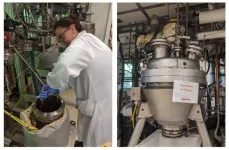The authors say that despite previous infection and the presence of antibodies, vaccination is still necessary to boost immune responses, prevent reinfection, reduce transmission, and that young people should take up the vaccine wherever possible.
In the study, between May and November 2020, around 10% (19 out of 189) of participants who were previously infected with SARS-CoV-2 (seropositive) became reinfected, compared with new infections in 50% (1,079 out of 2,247) of participants who had not previously been infected (seronegative).
Although the study was in young, fit, mostly male Marine recruits, the authors believe that the risk of reinfection found in their study will apply to many young people, but that the exact rates of reinfections will not be applicable elsewhere (owing to the crowded living conditions on a military base and close personal contact required for basic training likely contributing to a higher overall infection rate than seen elsewhere). For example, a study of 4 million people in Denmark also found that the risk of infection was five times higher in people who had not before had COVID-19, but they found that only 0.65% of people who had COVID-19 during Denmark's first wave tested positive again during the second wave, compared with 3.3% of people who tested positive after initially being negative [1]. In addition, a preprint study including British healthcare workers found that those who had been not previously infected had a five times higher risk of being reinfected than people who had a past infection [2].
Professor Stuart Sealfon, of Icahn School of Medicine at Mount Sinai, USA, and senior author of the study, says: "As vaccine roll outs continue to gain momentum it is important to remember that, despite a prior COVID-19 infection, young people can catch the virus again and may still transmit it to others. Immunity is not guaranteed by past infection, and vaccinations that provide additional protection are still needed for those who have had COVID-19." [3]
In the study, US Marine Corps recruits completed an unsupervised quarantine at home for two weeks before entering a Marine-supervised quarantine facility for another two weeks. They received antibody tests to establish whether any of the recruits were seropositive (they had previously been infected with SARS-CoV-2 and had antibodies). They were also tested for new SARS-CoV-2 infection at baseline then weeks one and two of the quarantine, and completed a questionnaire including demographic information, risk factors, medical history, and COVID-19 symptoms. Participants were excluded from the study if they tested positive for COVID-19 via PCR test during their supervised quarantine. After quarantine, recruits who did not have COVID-19 entered basic training and were tested for new SARS-CoV-2 infection by PCR tests every two weeks, for six weeks and completed follow up questionnaires about any COVID-19 symptoms.
Recruits who tested positive for a new second COVID-19 infection during the study were isolated and the study team followed up with additional testing. Levels of neutralising antibodies were also taken from subsequently infected seropositive and selected seropositive participants who were not reinfected during the study period.
Of the 2,346 Marines followed long enough for this analysis of reinfection rate, 189 were seropositive and 2,247 were seronegative at the start of the study. Across both groups of recruits, there were 1,098 (45%) new infections during the study. Among the seropositive participants, 19 (10%) tested positive for a second infection during the study. Of the recruits who were seronegative, 1,079 (48%) became infected during the study.
To understand why these reinfections occurred, the authors studied the reinfected and not infected participants' antibody responses. They found that, among the seropositive group, participants who became reinfected had lower antibody levels against the SARS-CoV-2 virus than those who did not become reinfected. In addition, in the seropositive group, neutralising antibodies were less common (neutralising antibodies were detected in 45 (83%) of 54 uninfected, and in six (32%) of 19 reinfected participants during the six weeks of observation).
Comparing new infections between seropositive and seronegative participants, the authors found that viral load (the amount of measurable SARS-CoV-2 virus) in reinfected seropositive recruits was on average only 10 times lower than in infected seronegative participants, which could mean that some reinfected individuals could still have a capacity to transmit infection, but the authors note that this will need further investigation.
In the study, most new COVID-19 cases were asymptomatic - 84% (16 out of 19 participants) in the seropositive group vs 68% (732 out of 1,079 participants) in the seronegative group - or had mild symptoms, and none were hospitalised.
Lt. Dawn Weir, of the Navy Medical Research Centre, USA, says: "Our study shows that some individuals with lower levels of neutralizing antibodies were reinfected, indicating that it is possible that previously infected and recovered people are susceptible to new SARS-CoV-2 infection at a later time. These reinfections may be asymptomatic, as observed in the majority of our participants. This is an important consideration for maintaining U.S. military operational readiness, such as preventing future COVID-19 outbreaks among Marine units or aboard Navy ships. The takeaway message for all young people, including our military service members, is clear - immunity resulting from natural infection is not guaranteed; you still need to be vaccinated even if you have had COVID-19 and recovered." [3]
The authors note some limitations to their study, including that it likely underestimates the risk of reinfection in previously infected individuals because it does not account for people with very low antibody levels following their past infection (in the study there were an unknown number of people in the seronegative group who had previously been infected but who did not have detectable levels of antibodies in their baseline antibody level test).
In the study there was a higher than usual drop-out rate of participants (a total of 566 participants - 34 recruits in the baseline seropositive group and 532 recruits in the baseline seronegative group - who began basic training and did not report for follow up two-weeks later). The study team were not told why any recruit did not return for follow up, but say that this could be a combination of individuals dropping out of the study, those who are transferred off the base for medical reasons, or who were separated from the US Marine Corps.
Lastly, the authors were unable to determine how seropositive recruits contracted their previous SARS-CoV-2 infection and confirm it by PCR test or determine how severe it was and what symptoms they had. They say they also could have missed detectable infections that occurred between the PCR testing every 2 weeks during the study.
Writing in a linked comment, María Velasco of Hospital Universitario Fundación Alcorcón, Spain, said: "This study was conducted in a closed setting but provides some interesting insights regarding the risk of subsequent SARS-CoV-2 infection in the general population or other settings. First, the rate of new SARS-CoV-2 PCR positive results is about 80% lower among seropositive individuals. These data confirm that seropositive individuals have a significant albeit limited protection for new infections [...] Second, the rate of new SARS-CoV-2 PCR detection among seropositive Marines cases is not negligible (1·1 cases per person-year), even in the young and healthy population. Globally, these results indicate that COVID-19 does not provide an almost universal and long-lasting protective immunity such as measles."
She continued: "Efforts must be made to reduce the risk of SARS-CoV-2 transmission from young oligosymptomatic individuals. Results from Letizia et al. suggest that even young individuals with a previous SARS-CoV-2 infection should also be a target of vaccination to avoid a poorly noticed source of transmission."
INFORMATION:
NOTES TO EDITORS
This study was funded by the Defense Health Agency and Defense Advanced Research Projects Agency. It was conducted by researchers from the Naval Medical Research Center, Icahn School of Medicine, Mount Sinai, New York, Naval Medical Research Unit SIX, Peru, University of Texas Medical Branch Galveston, University of Vermont and the Naval Medical Readiness and Training Command Beaufort.
The labels have been added to this press release as part of a project run by the Academy of Medical Sciences seeking to improve the communication of evidence. For more information, please see: http://www.sciencemediacentre.org/wp-content/uploads/2018/01/AMS-press-release-labelling-system-GUIDANCE.pdf if you have any questions or feedback, please contact The Lancet press office pressoffice@lancet.com
[1] https://www.thelancet.com/journals/lancet/article/PIIS0140-6736(21)00575-4/fulltext
[2] https://www.medrxiv.org/content/10.1101/2021.01.13.21249642v1
[3] Quote direct from author and cannot be found in the text of the Article
Peer-reviewed / Observational Study / People

